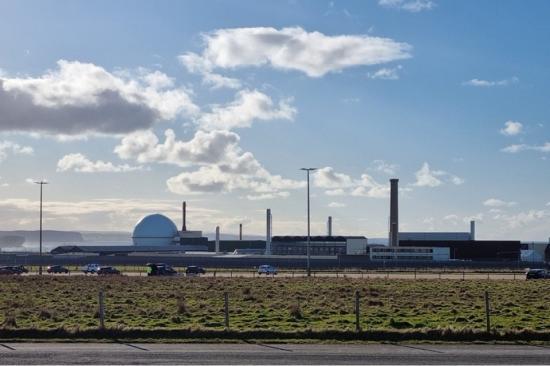Corwm Visits Dounreay Nuclear Site
23rd May 2024

Members were given an overview of the scale of the problem and challenges faced in the decommissioning of the site.
In the last week of March 2024, several members of CoRWM led by the Chair, Sir Nigel Thrift, made the long journey up to the North of Scotland to visit the Dounreay nuclear site, now managed by Nuclear Restoration Services.
Dounreay was established in 1955 and for many years was a world-leading nuclear research centre, focusing on research and development into fast breeder reactors. The ability of fast breeder reactors to produce more fuel than they consumed was highly relevant after the second world war, when the availability of uranium was limited.
The Dounreay site hosted 3 nuclear reactors:
the Materials Test Reactor
the Dounreay Fast Reactor
the Prototype Fast Reactor
It is the Dounreay Fast Reactor, located in the spherical building in the image below, that remains a local landmark. The Prototype Fast Reactor was the last reactor to be shut down in 1994 and the site is now Scotland's largest nuclear clean-up and demolition project.
During the visit to Dounreay CoRWM members were given an overview of the scale of the problem and challenges faced in the decommissioning of the site. The site has facilities that have a history of radioactive use and cover every aspect of the nuclear fuel cycle, from fuel fabrication to chemical separation and the disposal and storage of waste; the latter being of particular interest to CoRWM members.
Our visit began with a welcome and introduction to the site by Mac MacGill, the Security and Resilience Director, followed by technical discussions with Alan Mowat and Julian Ginniver. We then visited the low-level waste (LLW) facility, which currently has 2 near surface disposal vaults adjacent to the site. These vaults are expected to provide safe disposal for most of the low-level waste located on the Dounreay site, as more sustainable offsite options for some LLW are being investigated bringing the site into line with other NDA Operating Companies. We were able to walk inside these facilities and see the ISO containers that have already been immobilised into their final disposal location within the vault.
Our next visit was to the cementation facility within the Fuel Cycle Area. This facility is responsible for immobilising intermediate level raffinates (liquids separated during reprocessing) by mixing them with cement powder. The immobilised waste is packaged into 500-litre drums before moving into long term storage. The cementation facility was of particular interest to CoRWM members and there were wide ranging technical discussions on the progress that has been made with immobilising the waste from the Materials Test Reactor and the Dounreay Fast Reactor which is now complete and the relative pros and cons of cement immobilisation versus vitrification.
The visit to Dounreay gave CoRWM members a fascinating overview of the progress that the site has made with decommissioning, and the challenges that remain, some of which have been exacerbated by past decision making. This was most apparent in relation to the challenges faced in the retrieval, characterisation, and packaging of wastes from the site's shaft and silo. Whilst meeting the standard of the time, they no longer represent an acceptable waste management solution.
One thing which was very clear from the visit is that Dounreay has enormous technical expertise in nuclear waste handling, which will be invaluable as the UK progresses its ambitious nuclear programme. In particular, this expertise could make a significant contribution to ensuring that problematic waste streams are avoided in future advanced modular reactor designs.
The following day CoRWM visited the adjacent Vulcan Naval Reactor Test Establishment (NRTE), which, whilst reactor operations completed in 2015, is still undertaking operations in support of the Royal Navy's Submarine fleet.
For more photos go HERE
Related Businesses
Related Articles
